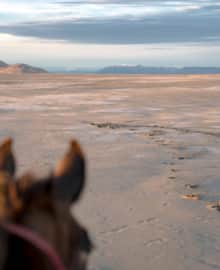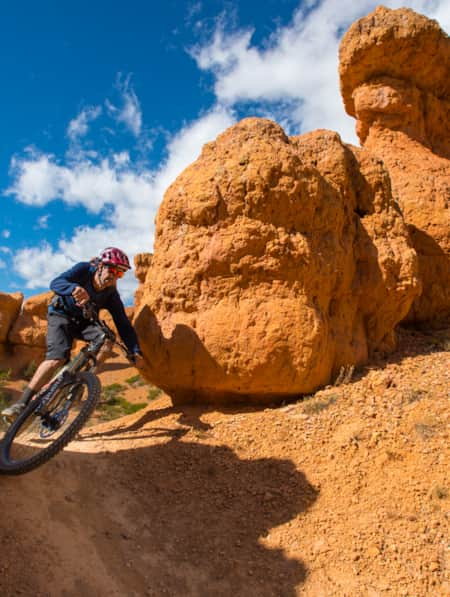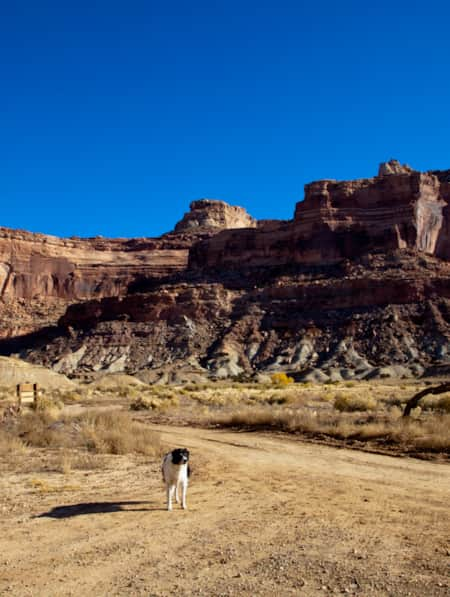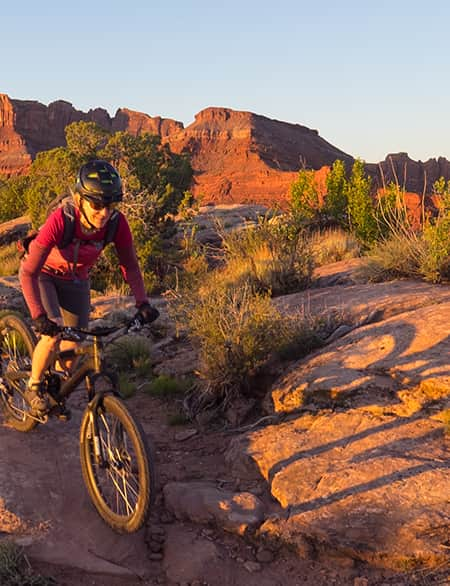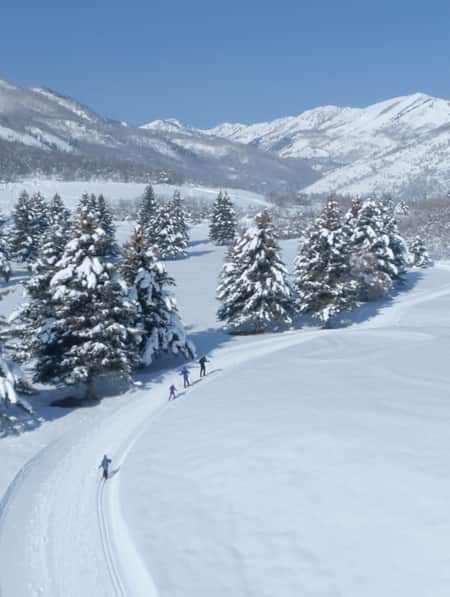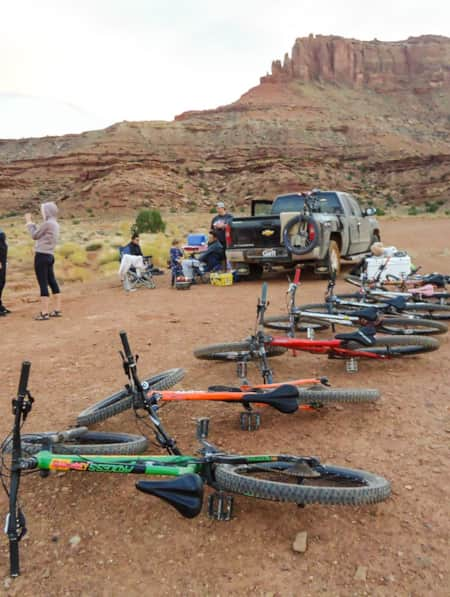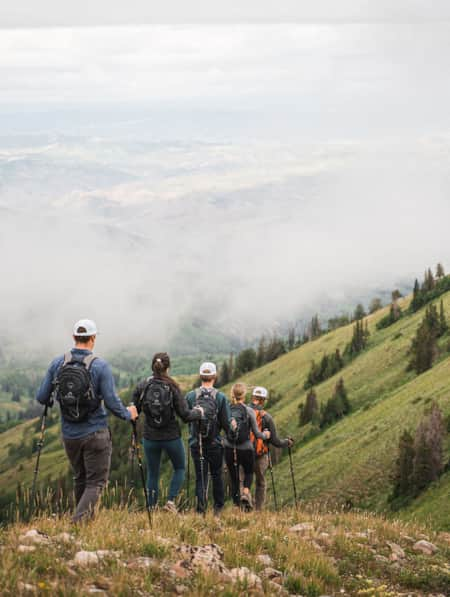Estrogen on Adrenaline: 48 Hours in Moab, Utah's Giant Playground
When an arbiter of pop culture declares that, “40 is the new 30,” I’m stuck wondering why 50 feels like 15. I just finished 48 Hours in Moab with four “midlife” women hiking, biking, crawling and craning our necks to a star-filled sky above Southern Utah, a place where time is relative and I felt very, very young.
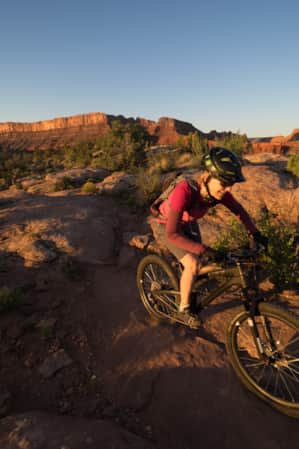
When an arbiter of pop culture declares that, “40 is the new 30,” I’m stuck wondering why 50 feels like 15. I just finished 48 Hours in Moab with four “midlife” women hiking, biking, crawling and craning our necks to a star-filled sky above Southern Utah, a place where time is relative and I felt very, very young.
Prologue — Ditch and Nudge
Sneaking off to Moab mid-week in May like kids playing hooky was the initial challenge for my co-venturers (Read: "The Best Time to Visit Moab"). Although setting the date months in advance wasn’t necessary — a 3.5-hour drive from our homes in Salt Lake City makes it an easy getaway — it provided our jobs and families enough notice to prepare for our absence, because it is an unwritten rule that everything and, I mean, everything apparently falls apart when The Mom, The Wife or The Boss isn’t around. Even worse, we sometimes fall apart.
“Oh my gosh, you are not giving up that easily!!” texted Julie in response to my attempt to cancel five days before departure. Sick for ten days did not qualify as an excuse, but not keeping up with the group on an outdoor adventure, I thought, might. “[Y]ou definitely don’t have to do everything...sleep and recover...rest...when I say “hike”—we are talking basically a walk with a little incline… Pleeaaaassee come!! It won’t be the same without you (sobbing emojis omitted).”
How could I refuse? Even now, I think those words of enthusiasm and friendship healed me faster and more effectively than any pill.
“600 milligrams of Motrin every six hours is the secret to everything in Moab,” joked Alison. Having hiked and biked with her before, I’m convinced her DNA testing kit revealed 25 percent mountain goat and shook my head. Moab is the ultimate playground for outdoor adventure, such as hiking, biking, rafting, rappelling, BASE-jumping, climbing, off-road driving and has some of the most-challenging and technical trails anywhere. However, it is most famous for mountain biking and, in recent years, has developed more beginner (green) and intermediate (blue) trails making it popular with families, a bunch of girlfriends or anyone new to the sport. In fact, the trail systems around Moab provide many intersecting loops and extensions allowing people of differing abilities to find and enjoy their best route.
“If you can ride a bike, you can mountain bike,” is my common refrain to women questioning whether they can ride.
Most women who grew up before cellphones and the Internet cruised neighborhoods on purple Schwinns with banana seats and handlebar streamers jumping curbs and standing on the pedals pushing to climb up their best friends’ driveways. Cycling was our ticket to freedom. We rode further than our parents knew or would allow, met girlfriends and boyfriends and explored our world returning only at dusk. Mountain biking in Moab is like that … just with more expensive, full-suspension carbon machines with big, knobby tires and dropper seat posts. Streamers are optional. With more bicycles than people, Moab has numerous places to rent mountain bikes for approximately $60 per day. If you keep your expectations in check, you can ride many terrific trails on your very first visit.
Day 1 — Intrepid Trails Mountain Biking
Pulling in late Monday afternoon, we drove straight to the Visitor Center at Dead Horse Point State Park to warm up our legs and clear our heads of all the details that fill our normal lives with a quick ride on the Intrepid Trail System. We strapped on our helmets, wiggled into our elbow, knee and shin pads and the dreaded but oh-so-necessary padded shorts, unloaded our mountain bikes and ventured out on the Big Chief Loop (comprised of Intrepid, Great Pyramid, Big Chief, Raven Roll Trails).
"'If you can ride a bike, you can mountain bike,' is my common refrain to women questioning whether they can ride. "
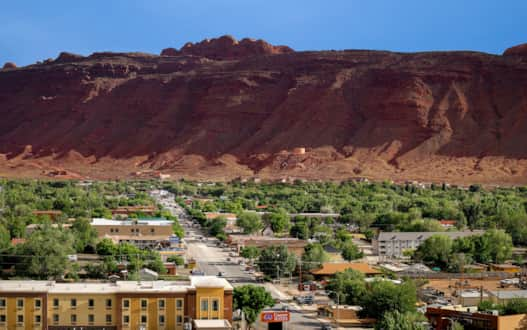
Photo: Marc Piscotty
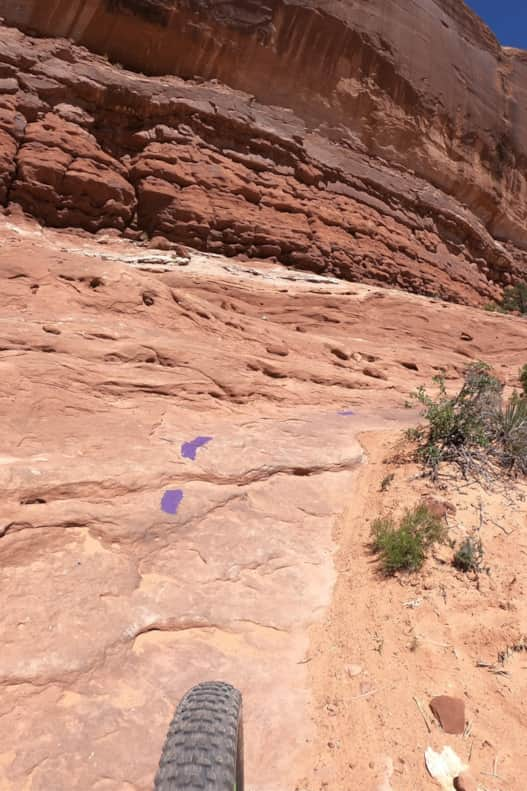
Photo: Paula Colman
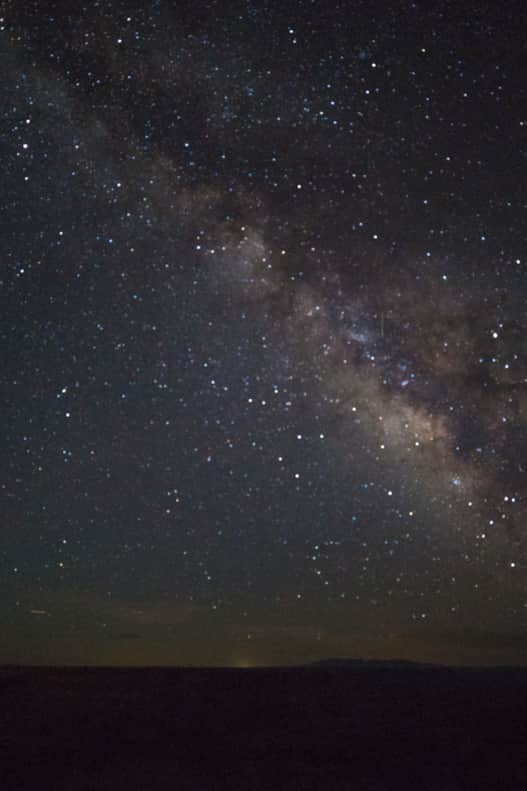
Photo: Sandra Salvas
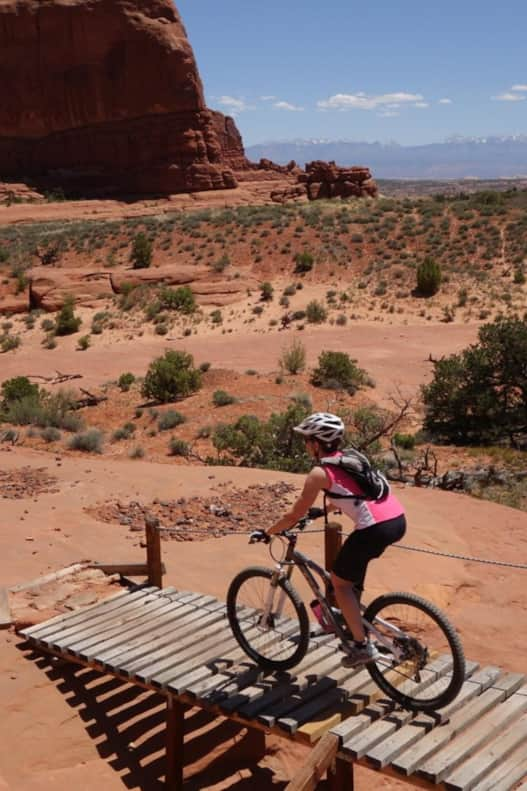
Photo: Paula Colman
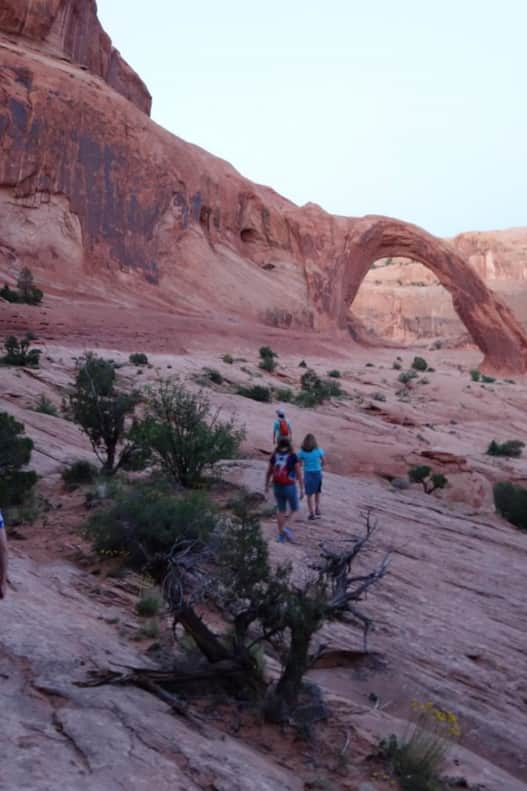
Photo: Paula Colman
There were a few rocky spots where we got off and walked, but this green-blue circuit was a terrific introduction to Moab mountain biking with a mix of singletrack and slickrock and stunning panoramic views of the mesas dotted between Canyonlands and Arches national parks. Half of our group wasn’t done after these eight miles, ventured across the main road to ride the other half of the Intrepid system and, then, rejoined the rest just up the road at Dead Horse Point where we scrambled over rocks like youngsters on a jungle gym to take in the iconic overhead views of Horseshoe Bend and White Rim Trail. After posing for stills and selfies (we have Instagram accounts, too), our stomachs announced it was time to get to town.
Night 1 — Cars and Stars
Much of Moab dining caters to the just-got-off-the-trail crowd. Showers and shoes are largely a personal choice. My dirty girl crew went directly to dinner at Giliberto’s, a taco restaurant on Highway 191, the north-south route through town, with its evening rush of returning SUVs, MTBs, ATVs, UTVs and other off-roading acronyms. Aside from satisfying guacamole and carne asada, the most notable thing about the place was the parking lot where every single car sported a rear rack with multiple mountain bikes dangling like diamond drop earrings and sparkling through caked dirt.
After dinner and a much-needed shower, the only things that shined brighter were the “billions and billions” of stars that stretched across the horizon. From the condo’s hot tub, we reclined our heads, raised our eyes and began recounting stars, skies and stories of our youth. Utah is home to over half of the world’s IDA-accredited International Dark Sky Parks and areas where light pollution (which, ironically if you think about it, didn’t exist before the Internet) does not interfere with observing the cosmos. In other words, Moab is one of the best places on Earth to see constellations we used to identify with star charts as kids. Gone are the dual-wheeled plastic-coated maps. Instead, Julie pulled out her cellphone and began pointing and spotting familiar planets and celestial celebrities like groupies at a Jackson Browne concert.
Day 2 — Navajo Rocks Trails Mountain Biking
After snoozing through my alarm (and, apparently, someone’s snoring), I found the ground coffee Kim thankfully packed and filled the pot as the rest of the group – some more energetic than others (some way more energetic) started their own morning rituals and preparations for the big day on the trail.
Some women, by nature or training, stuff more in their backpacks (and purses) than others, but those that try to wing it in Moab do so at their peril: water, snack, bike gear, sunscreen, camera, cellphone, dental floss…dental floss? “What the heck do you need that for?” I asked Margit. She replied with an arched eyebrow and that, “You never know…” look, one that only a mother can effectively wield as leverage against four towering boys and sassy girlfriends. When a chia seed became stuck between my back molars later that morning, there was no way I was going to ask for that doggone floss.
Although these women are fairly active, adventurous and extremely accommodating, each seemed to have individual expectations and limitations for biking that day: lots of mileage, lots of bumps, little climbing, fewer bumps. Navajo Rocks was a perfect choice. It is a series of trails that form a figure-eight pattern bisected by Highway 313 on the way to the Island in the Sky entrance of Canyonlands. Each part is named, marked and, most importantly, accurately described in terms of distance and topography in any number of online and printed maps. This meant we could plan two things: which sections we wanted to ride (Big Mesa and Ramblin); and how we wanted to ride them (from the center parking lot, going out-and-back on Big Mesa, and then continuing on Ramblin to the east parking lot).
Big Mesa is a mostly-blue 3.3 mile trail of rocks, slickrock slabs, ledges and bowls that follow the curve of red rock walls. It is stunning, and it is fun! Although I usually prefer riding point-to-point, Julie suggested riding out and back, which proved beneficial. Trails are always more difficult the first time. On the return, we knew what to expect. Our fingers loosened from the handlebars. We rode more aggressively (causing the chia seed to loosen from my teeth), and we rode just better.
Because we had two cars, we parked at different lots allowing us not only to shuttle but to give anyone a spot to take a break. Forget ego or peer pressure or YOLO. The prime directive among these women whether we are biking or hiking or anything else is, “We ride to ride another day.” So, after an exciting but technically-challenging ride out-and-back on Big Mesa, Margit wisely chose to give her back, which had major surgery just months ago, a rest. This adventure still had 24 hours left to enjoy.
If you’re thinking, “I’m not that adventurous, and I’m too old for that,” I’ll reveal that our posse ranged from 47 to 58 years with anywhere from 2 to 20 years of recreational (not YouTube-worthy) mountain biking experience, most of which was interrupted by kids and careers. For the most part, we’re still the girls on purple Schwinns climbing rocks and hills instead of curbs and driveways. We passed a couple of septuagenarians on Big Mesa who boasted with crossed arms and boyish grins that they recently took up biking in retirement. In this low-impact sport, age and experience are physically irrelevant and mentally advantageous (keeping you from doing really stupid YouTube-worthy stuff because, honestly, skinned knees hurt at any age). Although Moab has some of the most-famous and most-challenging trails in the world, its magic is that it has incredible trails for all levels and makes everyone on them feel like a kid with a red cape. Even better, it doesn’t require a substantial initial investment in gear or lessons, and it is a heckava lot warmer than skiing!
Although the trails are connected, Big Mesa and Ramblin look and feel more like cousins than siblings. Both are blue trails that run 3.3 miles each, but Ramblin moves away from the mesas that rise from the plateau offering a rollercoaster of smooth slickrock that just ... doesn’t ... seem ... to ... end, but when it does, it is usually for a few manageable rocks that, like an E-ticket amusement, have you click, click, clicking up to the apex before gravity takes you down again. The parking lot then appeared but much higher than it seemed it should be. We knew our Ramblin spin was over when trail markers painted on the rock pointed almost vertically toward the exit forcing us to walk the remainder and, between breaths, debate whether to order fries with our much-earned Atomic Burger.
Night 2 — Corona Arch Night Hike
After a fortuitous stop at Arches (more on that later), a leisurely lunch and siesta … Wait, wait, wait — I took a nap, Julie, Margit and Kim sunbathed by the pool, and Alison got back on her bike, rode from the restaurant along the Colorado River for several miles, turned around, rode back through town and rode several more miles south to the condo. She said she needed to relax. By late afternoon, with everyone recovered in their own way, we resupplied our backpacks for our next endeavor.
Driving back toward town, we turned west onto Scenic Byway 279 just before the entrance to Arches. This beautiful river road is a popular destination for climbers and campers. It also leads to the trailhead for Corona Arch, one of Utah’s largest sandstone monuments. Despite being located outside the national parks, its accessibility (well-marked 1.5-mile trail) and notoriety (dubbed The Rope Swing Arch on the video that has garnered almost 28 million views online) make it a heavily-visited site.
"For the most part, we’re still the girls on purple Schwinns climbing rocks and hills instead of curbs and driveways."
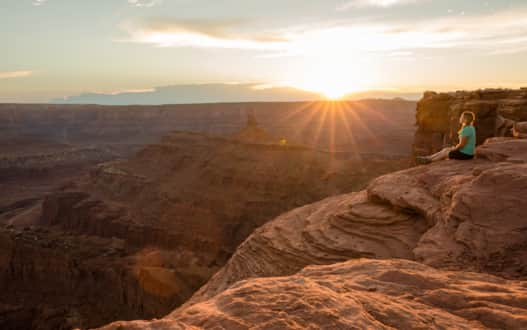
Photo: Shay Read
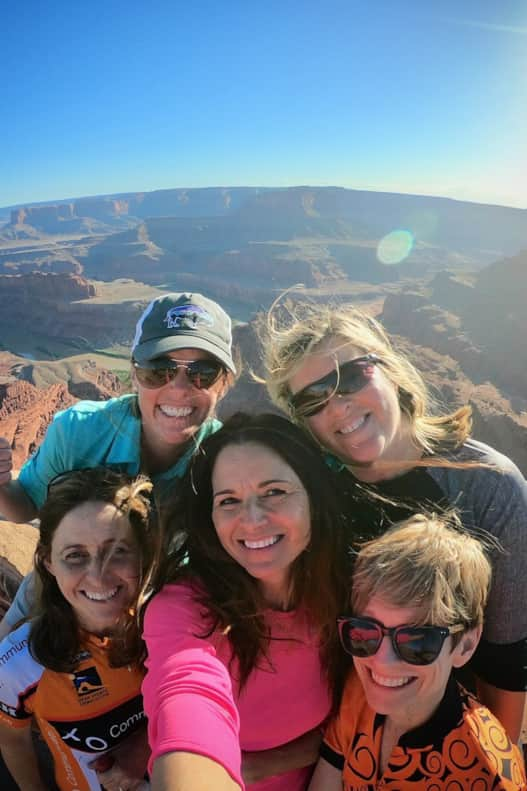
Photo: Paula Colman
During our trek, however, the place was deserted.
“Bring your headlamps,” said Julie, “Night hiking is great!” As we walked onto the path, the sun dropped quickly and, like a flood tide, people started heading back toward the parking lot as we ebbed further out. Soon, we were the only ones left. Around a bend, the Arch appeared. Presiding at the far end of Bootleg Canyon, Corona was, as its name suggested, a regal presence waiting for us to approach. Its aperture measured 110-feet high, stretched just as wide and was filled with the light from the setting sun reflected on the wall behind it. In a land of arches, it was impressive.
There was little elevation gain (440’) over the course of the trail, but some of it required the assistance of moki steps, safety cables and one slightly-askew metal ladder affixed to a rock. From there, we followed the cairns and painted lines that took us beneath the pothole-formation Bowtie Arch and continued to the base of Corona along a sandstone bench that, to the right, sloped steeply before dropping into the black canyon below.
None of this was visible beyond twilight.
And twilight came quickly. As we lay supine beneath the massive arch, a curtain came down upon the canyon floor and lights began twinkling above. Like the previous night, we were treated to an astral show beginning with a blaze of light streaking across the sky. Meteor? Perhaps. Magical? Definitely. Although none of us could capture it digitally, it was imprinted on our memories proving that we can still be awed in this, sometimes, overconnected world.
We took photographs, more selfies and videos until we couldn’t see our cameras or the Arch or the path marking our way out. Putting on headlamps helped (a little of that light pollution would have helped more). A twinge of anxiety was momentarily displaced placed by Minion jokes. Then, we followed each other very closely trying to avoid the slope and any other obstacle and to illuminate the next cairn against rock that now seemed to absorb, not reflect, the light.
“The ladder should be up ahead,” said someone. I didn’t look to see whom. I kept my eyes peeled on the back of Alison’s shoulder and tried to see whatever was in front of or beneath her. Walking on a moonless night was one thing; descending into darkness was another. Moki steps are indentations carved into vertical rocks and used as hand and foot holds. They are not symmetrical, and they are hard to see at night unless your headlamp is attached to your foot!
"Although none of us could capture it digitally, it was imprinted on our memories proving that we can still be awed in this, sometimes, overconnected world."
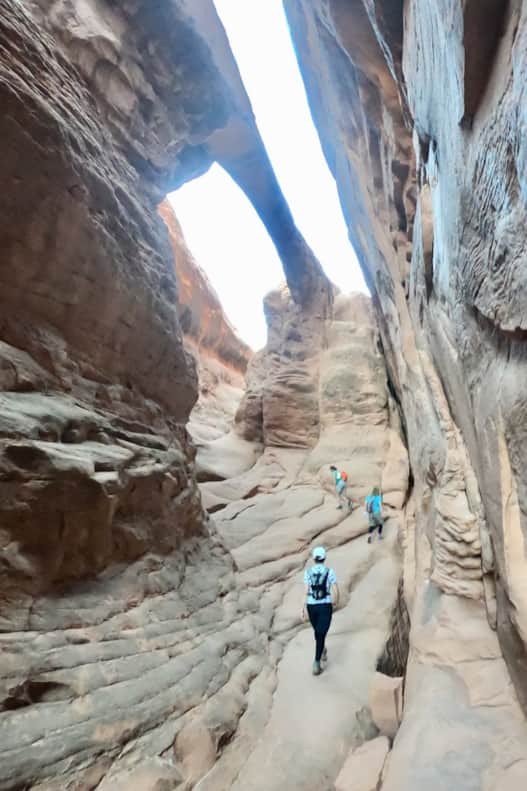
Photo: Paula Colman
Of course, we made it back to the car and the condo and, eventually, home. Corona Arch is one of Utah’s most-popular attractions on an easy, well-marked path during daylight hours. Hiking to it at night, while not deemed one of Corona’s banned “extreme activities,” such as swinging or rappelling, definitely raises the degree of difficulty (and heart rate) and should be attempted with caution, companions and extra batteries.
Day 3 — Fortuitous Fiery Furnace
A Moab hike where you are almost guaranteed to get lost — even during the day — is Fiery Furnace, an area of narrow sandstone fins and slabs inside Arches National Park. For years, the National Park Service (NPS) has controlled access to the Furnace by limiting the number of people on ranger-led tours and those granted self-guided permits.
I mentioned that we stopped the previous day at Arches, where we acquired five coveted permits.
Only recently, did NPS (specifically, a ranger with a warped sense of humor) put a few signposts and a dozen or so arrows along the maze-like Furnace. Each off-white arrow rests upon a brown background, the size of a business-card, and is attached to ancient rock making it perfectly camouflaged. More amusing, several waist-high guideposts within the Furnace warn, “Dead End Trail” but, in fact, lead to secret arches and other undisclosed highlights. Fortune favors the bold. The upside (and probable intent) is that the mystique and poor mapping keep the crowds away.
Despite having five sets of eyes and a handwritten “treasure map” from Alison’s sister, we still got lost in the Fiery Furnace — three times, at least — and we loved it. We arrived at 7:30am and, although we stayed three hours, we could have played in there all day along. There was no marked path; there was no path at all in spots. We rock scrambled and crab walked, slid sideways between fins, jumped and crawled over, under and around.
Playing in the park with friends. It was the culmination of 48 hours of adolescent adventure and inspiration to schedule our next girls’ trip soon.
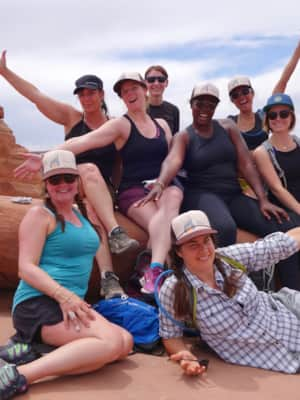
Women in the Wild: Transformation and the Outdoors
Paula Colman joins a weekend retreat for women in Moab, Utah, that has an eye-catching mission: Build your tribe. Connect with your inner spirit. Transform body, mind and spirit around the theme: “Ignite the Flame Within.” Follow along as she seeks her authentic self and learn how to find your own Tribe.
